Below are specific findings about news media attitudes and habits in Denmark. The findings come from a Pew Research Center survey about news media and politics across eight Western European countries conducted from Oct. 30 to Dec. 20, 2017. The survey covered five countries in the north (Denmark, Germany, the Netherlands, Sweden and the United Kingdom) and three in the south (France, Italy and Spain).
Views of the news media in Denmark
The sense of importance of and trust in the news media vary considerably by country. In general, adults in northern European countries – for example, Sweden and Germany – are more likely to say the news media are very important and that they trust the news media, while people in France and Italy are the least likely to say this.
In Denmark, 42% of adults consider the news media very important to society, and around half (47%) say they trust the news media. This includes just 10% of Danish adults who trust the news media a lot.
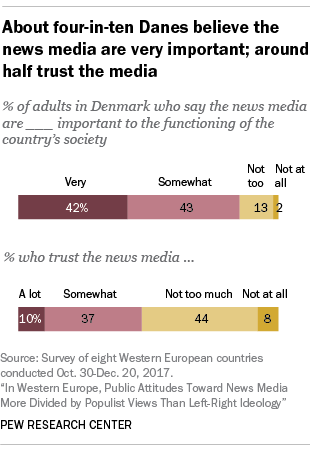
In most of the countries surveyed, people who hold populist views are less likely to say the news media are important and to trust the news media than people who don’t hold populist views. In general, the differences in these attitudes about the news media are small when comparing between people on the left and right of the ideological spectrum.
This pattern holds true in Denmark as well: 37% of people with populist views say the news media are very important to society, compared with 48% of those with non-populist views. On the question of trust, 34% of people with populist views say they trust the news media, compared with 56% of those without populist views.
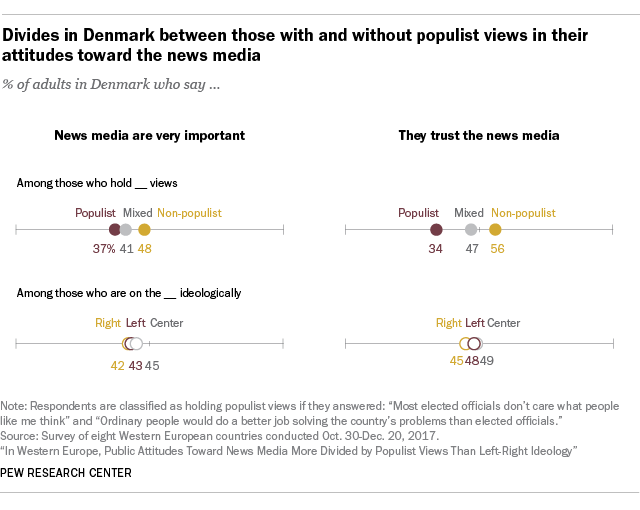
Main sources used for news in Denmark
When it comes to the news sources people say they turn to most frequently, the divides between adults with and without populist leanings are not as strong as those seen for attitudes about the news media more generally. And in the southern countries, there tend to be larger divides in main news source preference between people on the left and right of the ideological spectrum than between those with and without populist views.
In Denmark, those on the left and right differ somewhat in the media sources they turn to most for news, but both sides name the same top two main sources (DR News and TV 2 News).
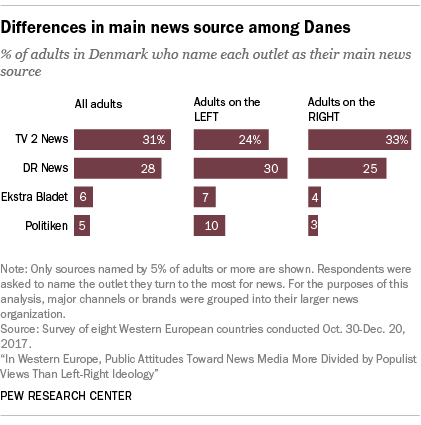
Where users place outlets’ ideologies, on the right and on the left
For many of the news outlets across the eight countries, people who use an outlet to get news tend to think the outlet is closer to their own left-right ideological position. In Denmark, this is true for seven of the eight outlets asked about: DR News, TV 2 News, Politiken, Jyllands-Posten, Ekstra Bladet, Børsen and Information. For these outlets, news users on either the right or left tend to place them closer to their own ideology. The one exception is the tabloid newspaper BT, which right- and left-aligned news users agree on its placement.
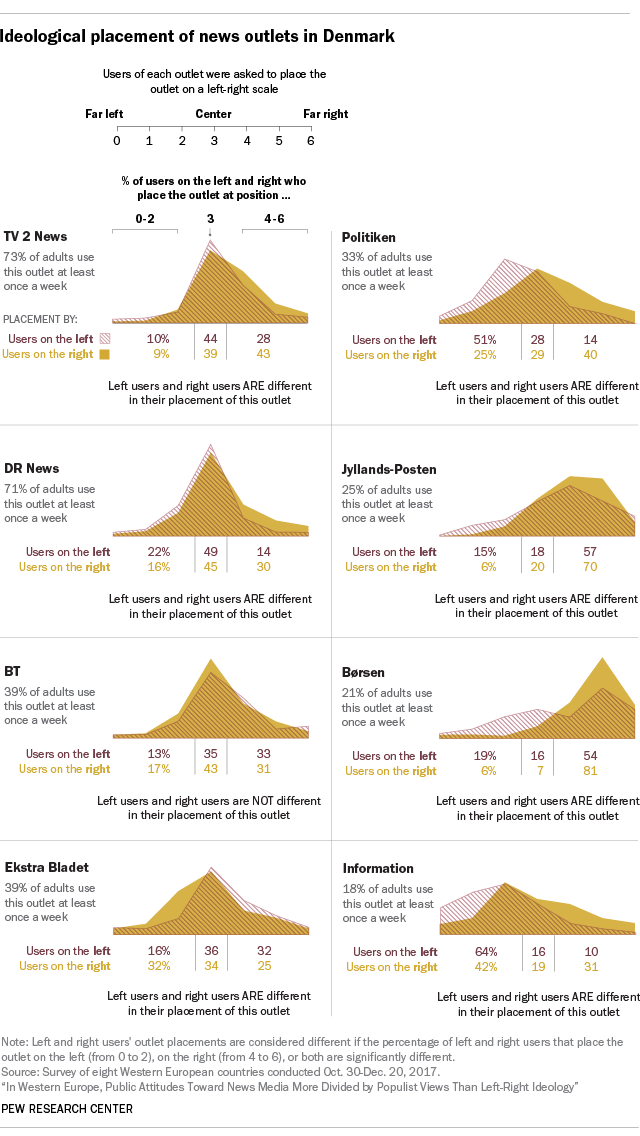
In general, where the public places an outlet tends to differ from where the average audience actually sits ideologically. For each of the news outlets asked about in the survey, the average audience (based on self-reported usage) tends to fall near the ideological center. People who have heard of each outlet, however, tend to place the outlet either farther to the left or farther to the right than the actual ideological position of the outlet’s audience.
Denmark is a slight exception. For some outlets, while outlets’ news audiences are near the ideological center, people who have heard of each outlet tend to think the outlets lean slightly more to the right. Børsen, for example, has an audience that sits at about the middle of the left-right spectrum (3.5 on the 0-to-6 scale), but when asked to place the outlet on the same left-right scale, people who have heard of Børsen place it farther to the right (at 4.2). For most of the outlets asked about in Denmark, though, there is little difference between where people place each outlet and its audience’s ideological position.
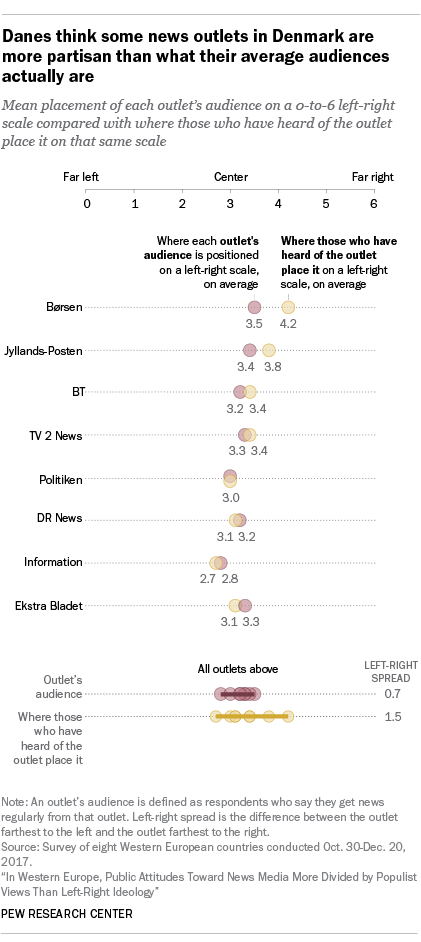
Trust in news media outlets
In seven of the eight countries surveyed, the most trusted news outlet asked about is the public news organization in each country. This is the case in Denmark, where the two most trusted outlets, TV 2 News (trusted by 80% of Danes) and DR News (trusted by 79%) are both public broadcasters.
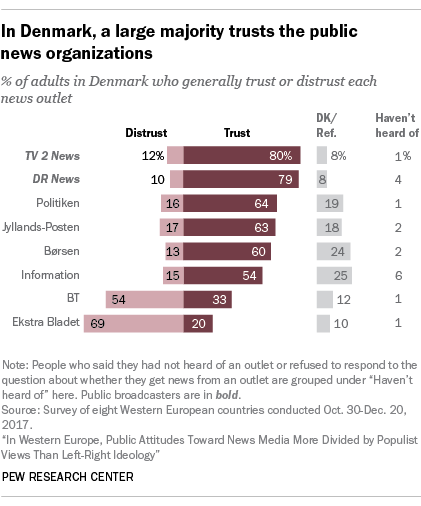
As with trust in the news media generally, trust in specific outlets varies by populist leanings, with those who hold populist views expressing lower levels of trust than those who don’t.
In Denmark, these differences are stark. For example, those with populist leanings are 22 percentage points less likely than those with non-populist views to say they trust Jyllands-Posten. When it comes to left-right ideological differences, though, those who place themselves on the left of the 0-to-6 ideological scale are only 11 percentage points less likely than people on the right to trust Jyllands-Posten.
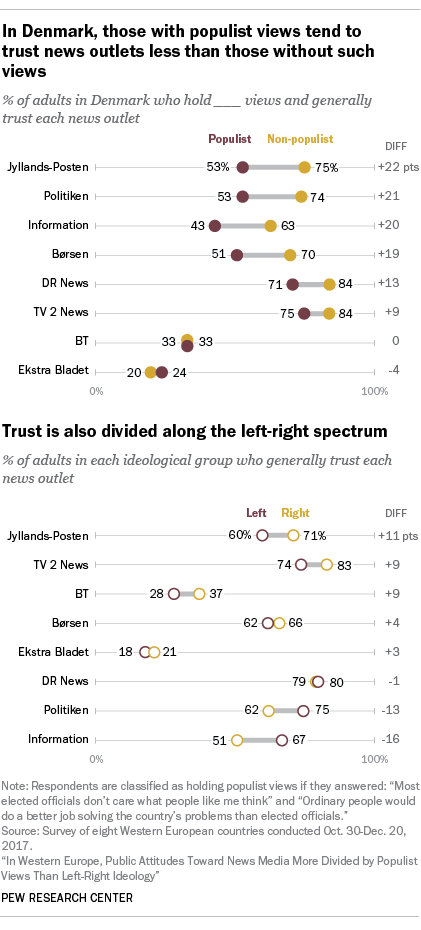
Social media usage and views
Many people in Western Europe get news through social media, with Facebook cited as the most widely used platform for news.
In Denmark, 66% of adults get news on social media, including 46% who get news on social media daily. Facebook is the most common social network used for news. In Denmark, young people (those 18 to 29 years old) are more likely to get news on social media daily than those 50 and older (75% vs. 28%).
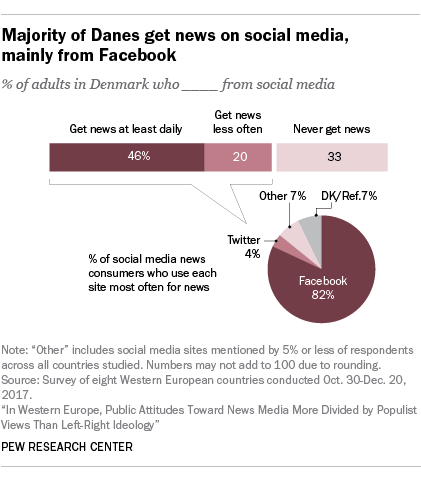
About half or more social media news consumers in each of the eight countries surveyed say they are familiar with the sources they see on social media. Still, sizeable minorities say they typically do not pay attention to the source of the news they encounter there.
Social media news consumers in Denmark are similar to other Western Europeans – 72% are familiar with the news sources they find on social media, but roughly a fifth do not pay attention to the sources there.
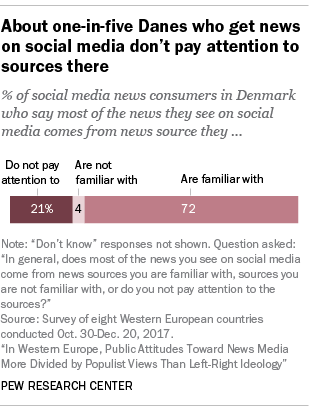
Find out more
Read the methodology and full report for more on Denmark and the other seven Western European countries included in the survey. For global data on media habits and attitudes see the report “Publics Globally Want Unbiased News Coverage, but Are Divided on Whether Their News Media Deliver.”